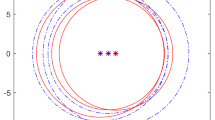Abstract
In this paper, we obtain a new estimate for the (product) \(\gamma \)-diagonally dominant degree of the Schur complement of matrices. As applications we discuss the localization of eigenvalues of the Schur complement and present several upper and lower bounds for the determinant of strictly \(\gamma \)-diagonally dominant matrices, which generalizes the corresponding results of Liu and Zhang (SIAM J. Matrix Anal. Appl. 27 (2005) 665-674).

Similar content being viewed by others
Data availability
Not Applicable.
References
Carlson D, Markham T (1979) Schur complements of diagonally dominant matrices. Czech Math J 29(104):246–251
Cui J, Peng G, Lu Q, Huang Z (2017) The new improved estimates of the dominant degree and disc theorem for the Schur complement of matrices, Linear Multilinea. Algebra 65:1329–1348
Cvetković L, Nedović M (2009) Special \(H\)-matrices and their Schur and diagonal-Schur complements. Appl Math Comput 208:225–230
Cvetković L, Nedović M (2012) Eigenvalue localization refinements for the Schur complement. Appl Math Comput 218:8341–8346
Gu J, Zhou S, Zhao J, Zhang J (2021) The doubly diagonally dominant degree of the Schur complement of strictly doubly diagonally dominant matrices and its applications. Bull Iran Math Soc 47:265–285
Horn RA, Johnson CR (1985) Matrix Analysis. Cambridge University Press, New York
Horn RA, Johnson CR (1990) Topics in Matrix Analysis. Cambridge University Press, New York
Li CK (2000) Extremal characterizations of the Schur complement and resulting inequalities. SIAM Rev 42:233–246
Li B, Tsatsomeros M (1997) Doubly diagonally domiant matrices. Linear Algebra Appl 261:221–235
Li GQ, Liu JZ, Zhang J (2017) The disc theorem for the Schur complement of two class Submatrices with diagonally dominant properties. Numer Math Theor Meth Appl 10:84–97
Li C, Huang Z, Zhao J (2022) On Schur complements of Dashnic-Zusmanovich type matrices. Linear Multilinear Algebra 70:4071–4096
Liu JZ, Huang YQ (2004) Some properties on Schur complements of \(H\)-matrices and diagonally dominant matrices. Linear Algebra Appl 389:365–380
Liu JZ, Huang ZJ (2010) The Schur complements of \(\gamma \)-diagonally and product \(\gamma \)-diagonally dominant matrix and their disc separation. Linear Algebra Appl 432:1090–1104
Liu JZ, Zhang FZ (2005) Disc separation of the Schur complements of diagonally dominant matrices and determinantal bounds. SIAM J Matrix Anal Appl 27:665–674
Liu JZ, Huang YQ, Zhang FZ (2004) The Schur complements of generalized doubly diagonally dominant matrices. Linear Algebra Appl 378:231–244
Liu JZ, Huang ZJ, Zhang J (2010) The dominant degree and disc theorem for the Schur complement. Appl Math Comput 215:4055–4066
Liu JZ, Zhang J, Liu Y (2012) The Schur complement of strictly doubly diagonally dominant matrices and its application. Linear Algebra Appl 437:168–183
Liu JZ, Zhang J, Zhou LX, Tu G (2018) The Nekrasov diagonally dominant degree on the Schur complement of Nekrasov matrices and its applications. Appl Math Comput 320:251–263
Liu JZ, Xiong YB, Liu Y (2022) The closure property of the Schur complement for Nekrasove matrices and its applications in solving large linear systems with Schur-based method. Comput Appl Math 39:290
Ostrowski AM (1951) Uber das Nichverchwinder einer Klass von Determinanten und die Lokalisierung der charakterischen Wurzeln von Matrizen. Composition Math 9:209–226
Sang C (2021) Schur complement-based infinity norm bounds for the inverse of DSDD matrices. Bull Iran Math Soc 47:1379–1398
Smith RL (1992) Some Interlacing Properties of the Schur Complement of a Hermitian Matrix. Linear Algebra Appl 177:137–144
Song X, Gao L (2023) On Schur Complements of Cvetković-Kostić-Varga Type Matrices. Bull Malays Math Sci Soc 46:49
Varga RS (2004) Geršgorin and his circles. Springer-Verlag, Berlin
Zhang FZ (2006) The Schur Complement and Its Applications. Springer, Berlin
Zhang C, Xu C, Li Y (2007) The eigenvalue distribution on Schur complements of \(H\)-matrices. Linear Algebra Appl 422:250–264
Zhang J, Liu JZ, Tu G (2013) The improved disc theorems for the Schur complements of diagonally dominant matrices. J Ineq Appl 2013:16
Zhou LX, Lyu ZH, Liu JZ (2022) The Schur Complement of \(\gamma \)-Dominant Matrices. Bull Iran Math Soc 48:3701–3725
Acknowledgements
The authors thank Dr. Shiyun Wang and Mr. Qi Li for their good suggestions which improve the presentation of this manuscript.
Funding
The work was supported by Guangxi Provincial Natural Science Foundation of China (No. 2023GXNSFAA026514) and the National Nature Science Foundation of China (No. 12171323,12301591).
Author information
Authors and Affiliations
Corresponding author
Ethics declarations
Conflict of interest
The authors declare that they have no Conflict of interest.
Ethical approval
Not Applicable.
Additional information
Publisher's Note
Springer Nature remains neutral with regard to jurisdictional claims in published maps and institutional affiliations.
Rights and permissions
Springer Nature or its licensor (e.g. a society or other partner) holds exclusive rights to this article under a publishing agreement with the author(s) or other rightsholder(s); author self-archiving of the accepted manuscript version of this article is solely governed by the terms of such publishing agreement and applicable law.
About this article
Cite this article
Lyu, Z., Zhou, L. & Ma, J. The \(\gamma \)-diagonally dominant degree of Schur complements and its applications. Comp. Appl. Math. 43, 342 (2024). https://doi.org/10.1007/s40314-024-02868-3
Received:
Revised:
Accepted:
Published:
DOI: https://doi.org/10.1007/s40314-024-02868-3




